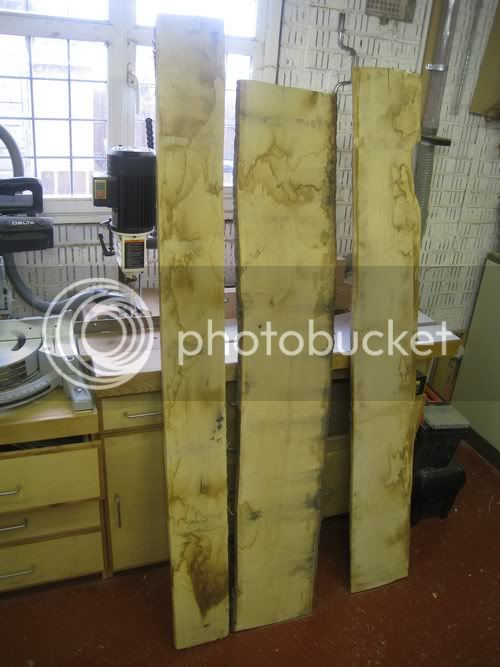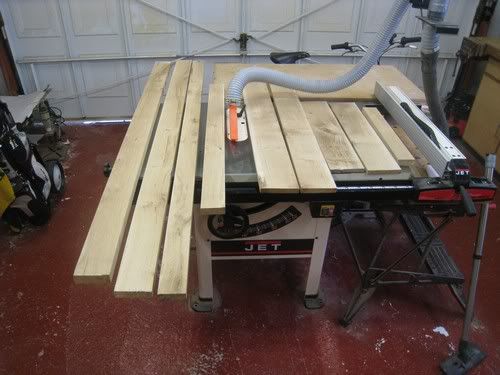Some of you may have seen my other thread (still ongoing) about me setting up a home workshop for hobby purposes. I don't know a lot about grades of wood and such, but I've been learning! Initially I was looking at PAR (planed) wood but I have since discovered that there is such a machine as a "planer/thicknesser" and I have calculated that over time I will save money by buying "sawn" wood and doing the planing/thicknessing myself. Well, that's the general idea anyway! 
So I have been looking around for a thicknesser and I have turned to good old eBay. Initially I thought maybe get a second-hand one but I really do not know what I am looking at in this area and so it might be unwise for me to do this. Plus as they are big, heavy machines most people specify pickup only, which will not suit me. I have found a couple of new machines at prices I can afford, but as I really do not know much about this sort of thing I need some help determining whether to go ahead or not!
The three machines I am looking at are:
Ryobi Planer Thicknesser ETP1531AK
1,500W
315mm planing width
5-153mm thicknessing
0-3mm cut depth
10,000rpm no-load speed
10,000 cuts/min
2 knives
8m/min feed rate
£220 delivered
Charnwood Portable 318mm Thicknesser W570
1,500W
330mm planing width
?-153mm thicknessing
0-3mm cut depth
8,000rpm no-load speed
16,000 cuts/min
2 knives
8m/min feed rate
£195 delivered
SIP Thicknesser 01333
1,800W 2.5hp
318mm planing width
?-160mm thicknessing
0-3mm cut depth
8,000rpm no-load speed
16,000 cuts/min
? knives
8m/min feed rate
£225 delivered
In choosing I basically looked for the ones that take the largest size of wood. Although I doubt I will ever use something as large as 30x15xm, I figure it's useful to have the capacity there and the machine should therefore handle smaller sizes with ease...? I have no idea about comparisons of use - all three machines seem to have roughly the same specs for roughly the same prices. I don't know what cuts/min means in any real sense to me, and although I've heard of Ryobi and think they are an okay brand (?) I have not heard of the other two...
In terms of how much use the machine would get, I'd say 100m of wood within the first month and maybe 400m per year. If I have my sums right that means that after one year it would have paid for itself. Although I will mainly be using softwood I'm assuming it will be okay to use it for hardwood as well - or have I got that wrong?
I'm imagining that I simply buy one of these things, set it to the size of wood that I want, and push the wood through. I'm a bit hazy as to how that actually works, but I'm figuring I'll find out when using it - it can't be all that hard can it?!
So basically a summary of what I'm trying to find out here is:
1. Are any of those machines suitable for me
2. Which one would be recommended
3. Are the prices worth going for or should I look elsewhere
4. Can I use it for hardwood as well as softwood
5. Is there anything I'm missing here... is the whole thing a good idea!
And I guess an extra question would be whether it's okay to buy sawn "fifths"-grade wood or not. I'm still confused about the tangible differences *to me* of fifths versus unsorted.
Many thanks!
So I have been looking around for a thicknesser and I have turned to good old eBay. Initially I thought maybe get a second-hand one but I really do not know what I am looking at in this area and so it might be unwise for me to do this. Plus as they are big, heavy machines most people specify pickup only, which will not suit me. I have found a couple of new machines at prices I can afford, but as I really do not know much about this sort of thing I need some help determining whether to go ahead or not!
The three machines I am looking at are:
Ryobi Planer Thicknesser ETP1531AK
1,500W
315mm planing width
5-153mm thicknessing
0-3mm cut depth
10,000rpm no-load speed
10,000 cuts/min
2 knives
8m/min feed rate
£220 delivered
Charnwood Portable 318mm Thicknesser W570
1,500W
330mm planing width
?-153mm thicknessing
0-3mm cut depth
8,000rpm no-load speed
16,000 cuts/min
2 knives
8m/min feed rate
£195 delivered
SIP Thicknesser 01333
1,800W 2.5hp
318mm planing width
?-160mm thicknessing
0-3mm cut depth
8,000rpm no-load speed
16,000 cuts/min
? knives
8m/min feed rate
£225 delivered
In choosing I basically looked for the ones that take the largest size of wood. Although I doubt I will ever use something as large as 30x15xm, I figure it's useful to have the capacity there and the machine should therefore handle smaller sizes with ease...? I have no idea about comparisons of use - all three machines seem to have roughly the same specs for roughly the same prices. I don't know what cuts/min means in any real sense to me, and although I've heard of Ryobi and think they are an okay brand (?) I have not heard of the other two...
In terms of how much use the machine would get, I'd say 100m of wood within the first month and maybe 400m per year. If I have my sums right that means that after one year it would have paid for itself. Although I will mainly be using softwood I'm assuming it will be okay to use it for hardwood as well - or have I got that wrong?
I'm imagining that I simply buy one of these things, set it to the size of wood that I want, and push the wood through. I'm a bit hazy as to how that actually works, but I'm figuring I'll find out when using it - it can't be all that hard can it?!
So basically a summary of what I'm trying to find out here is:
1. Are any of those machines suitable for me
2. Which one would be recommended
3. Are the prices worth going for or should I look elsewhere
4. Can I use it for hardwood as well as softwood
5. Is there anything I'm missing here... is the whole thing a good idea!
And I guess an extra question would be whether it's okay to buy sawn "fifths"-grade wood or not. I'm still confused about the tangible differences *to me* of fifths versus unsorted.
Many thanks!



































